 W
WThe Abbott Memorial Library is the public library serving the village of South Pomfret, Vermont. It is located at 15 Library Street, in an architecturally distinguished building constructed in 1905 through a bequest of the local Abbott family. The building was listed on the National Register of Historic Places in 2015.
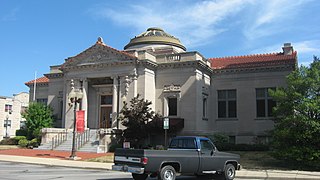 W
WThe Anderson Center for the Arts is located in downtown Anderson, Indiana at 32 West 10th Street in the former Carnegie Library building built partly in honor of educator and railroad executive John Byers Anderson. The building, as Carnegie Public Library, is listed in the National Register of Historic Places.
 W
WThe Arcola Carnegie Public Library is a Carnegie library located at 407 E. Main St. in Arcola, Illinois. The library was built in 1905 through a $10,000 grant from the Carnegie Foundation. Architect Paul O. Moratz designed the library in the Classical Revival style. The building's front entrance is situated within a Classical gabled portico supported by stone pilasters. The hipped roof of the building features an ornamental cornice along its edge and a cupola at its peak. The building still serves as Arcola's public library and houses a collection of over 18,000 books.
 W
WThe Ardmore Carnegie Library, at 511 Stanley SW. in Ardmore, Oklahoma, is a Carnegie library built in 1905. It was listed on the National Register of Historic Places in 2000. It has also been known as the Ardmore Garden Clubs Building.
 W
WBlack Watch Library is a historic library building located at Ticonderoga in Essex County, New York. It was built in 1905 and is a one-story brick structure with a cruciform plan in the Jacobean Revival style. It features a blue / green slate gable roof with projecting rafter ends.
 W
WThe Camden Free Public Library Main Building is the first former main library of the Camden, New Jersey public library system. Designed by Herbert D. Hale and Henry G. Morse, the building was constructed with a grant from the Carnegie Corporation and opened in 1905. It closed in 1986 with the relocation of the library's main branch to the former South Jersey Gas, Electric and Traction Company Office Building. In 1992, the building was placed on the state and national registers of historic places. The building has fallen into state of serious disrepair. In 2003, funding was found for its stabilization, with the hope that it would be preserved and re-used.
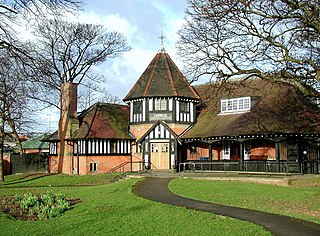 W
WThe Carnegie Heritage Centre is a grade II listed building in Hull, England, which was designed as a Carnegie library.
 W
WThe Parkersburg Carnegie Library is a historic library building located at Parkersburg, Wood County, West Virginia. It was designed and built in 1905, with funds provided by the philanthropist Andrew Carnegie. It is one of 3,000 such libraries constructed between 1885 and 1919. Carnegie provided $34,000 toward the construction of the Parkersburg library. It is a two-story, "L"-shaped brick structure in the Classical Revival style. The facade is detailed in gray stone and features a pediment with two Doric order columns. It ceased use as a library about 1975, and in December 1985, it was re-opened, as Trans Allegheny Books, which was the largest used book store in West Virginia until it closed in 2010.
 W
WThe Carnegie Library Building in Carroll, Iowa, United States, is a building from 1905. The 60-by-38.5-foot structure was designed in the Prairie School style by Omaha architect Thomas R. Kimball. The Carnegie Corporation of New York had accepted Carroll's application for a grant for $10,000 on February 12, 1903. It was listed on the National Register of Historic Places in 1976.
 W
WThe Carnegie Public Library is a Neoclassical building designed by Tourtellotte & Co. and constructed in Boise, Idaho, in 1904–1905. It was individually listed on the National Register of Historic Places in 1974. In 1982 it was included as a contributing property in the Fort Street Historic District.
 W
WThe Carnegie-Ellsworth Public Library is a historic building located in Iowa Falls, Iowa, United States. Local businessman Eugene Ellsworth donated the property for the library in 1902. The following year the Carnegie Foundation agreed to grant the community $10,000 to build the building. It was dedicated on August 9, 1904. The single-story, brick structure is dominated by an elaborate entrance pavilion. It features a semi-circular window above the cornice, which is supported by two Ionic pillars in antis between rusticated corner piers. The hip roof is capped by a cupola. The building was listed on the National Register of Historic Places in 1983. The Robert W. Barlow Memorial Library, Iowa Falls' public library, is now housed in a modern building near the Iowa River.
 W
WThe Cherokee Public Library is located in Cherokee, Iowa, United States. A library was begun in town in 1886 by the Cherokee Ladies Library Association. The collection of books was housed in the YMCA and other shared facilities. It was poorly funded, and the city of Cherokee took over the library in 1898 after voters passed a referendum. The Carnegie Corporation of New York had accepted the city's application for a grant for $10,000 on January 6, 1903. They hired Oskaloosa, Iowa architect Frank E. Wetherell to design the new building, which was built by Hansen and Lambkin of New Hampton, Iowa. Carnegie donated a further $2,000 to complete construction. It was dedicated on May 2, 1905.
 W
WClitheroe Library is a Carnegie library in Clitheroe, Lancashire, England. It was opened in 1905.
 W
WDanforth Memorial Library, also known as the Paterson Free Public Library, is located in Paterson, Passaic County, New Jersey, United States. The library was built in 1905 and was added to the National Register of Historic Places on March 1, 1984.
 W
WThe Everett Carnegie Library is a Carnegie library building located in Everett, Washington, USA listed on the National Register of Historic Places and part of the Snohomish County Government campus. The building occupies the southeast corner of the intersection of Oakes Avenue and Wall Street in the city's central business district.
 W
WThe Everett Public Library (EPL) serves the residents of Everett, Washington. EPL operates a main library at 2702 Hoyt Avenue and the Evergreen branch, at 9512 Evergreen Way. The main library overlooks Puget Sound and the southern end of Whidbey Island. The library has noteworthy artworks, including works by Dudley Pratt, Ransom Patrick, Guy Anderson, Jack Gunter, and Sonja Blomdahl. The library circulates over 900,000 items per year, provides exceptional book and media collections, reference services, on-line resources, in-home library services, and programs for adults, children and families. The library's staff includes specialists in adult reference, children's books, and local history. The Everett Public Library introduced a bookmobile service in May 1924; the first of its kind in Washington state, and the second in the West. It is also one of the few public library systems in the United States that has two full-time history specialists on staff. Northwest Room co-founders Margaret Riddle and David Dilgard retired after 31 and 40 years respectively, and their positions are currently filled by Lisa Labovitch with the second role waiting to be posted.
 W
WThe Free Public Library of Kaukauna is affiliated with the Outagamie Waupaca Library System. It was added to the National Register of Historic Places in 1984 for its significance in education and community planning and development.
 W
WFulton Public Library is a historic library building located at Fulton in Oswego County, New York. It is a masonry structure built in 1905–1906 in the Beaux-Arts style. The building is built on a steeply sloped lot and is two stories at street level and four stories behind. It was designed and built with funds provided by the philanthropist Andrew Carnegie. It is one of 3,000 such libraries constructed between 1885 and 1919, and one of 107 in New York State. Carnegie provided $15,000 toward the construction of the Fulton library.
 W
WThe Greenville Public Library is located in the Bond County, Illinois city of Greenville. It was built in 1905 and was added to the National Register of Historic Places in 1995.
 W
WThe Hanford Carnegie Library, now the Hanford Carnegie Museum, is a museum in Hanford, Kings County, central California.
 W
WThe Hanover Town Library, also known as the Etna Library, is a historic branch library located at 130 Etna Road in Hanover, New Hampshire, United States. It serves the Etna section of the town; the Classical Revival building it occupies was the first purpose-built library building in the town, and is listed on the National Register of Historic Places. It is a modest brick building, designed by Dartmouth College professor Robert E. Fletcher and built in 1905.
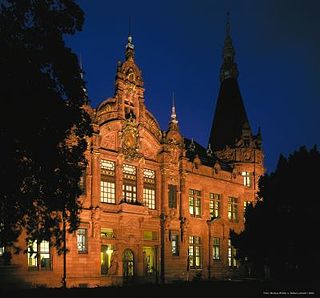 W
WThe University Library Heidelberg is the central library of the University of Heidelberg. It constitutes together with the 83 decentralized libraries of the faculties and institutes the University Library System, which is headed by the director of the University Library. The University Library holds special collections in literature concerning the Palatinate and Baden, egyptology, archeology, the history of art, and South Asia. It holds about 3.2 million books, 10,732 scientific periodicals, and about 500,000 other media such as microfilms and video tapes. It holds 6,600 manuscripts, 1,800 incunabula, 110,500 autographs, and a collection of old maps, paintings, and photographs. The libraries of the faculties and institutes hold another 3.5 million printed books. In 2005, 34,500 active users of the University Library accessed 1.4 million books a year. The conventional book supply is complemented by numerous electronic services, such as 3,000 commercial scientific journals that can be accessed via e-journal.
 W
WThe Kenton Public Library is a historic building in downtown Kenton, Ohio, United States. One of 109 Carnegie libraries in Ohio, it was designed in 1905 by the architectural firm of Richards, McCarty and Bulford; Carnegie donated $20,000 to aid in its construction. An attempt to start a library in Kenton began in 1853, but over thirty years passed before one was actually begun. From 1886 to the opening of the Carnegie library, the library was housed in a business block on the city's central square. The library building is a one-and-one-half-story brick structure. An elevated foundation supports the rectangular structure, which is accessed from the street by a staircase.
 W
WThe Litchfield Public Library is a Carnegie library located at 400 N. State St. in Litchfield, Illinois. The library was built in 1904-05 through a $10,000 donation from the Carnegie Foundation. Litchfield's library program had been in existence since 1882; prior to the construction of the library, it had been housed in the Cline Building and later the First National Bank, but by the early 1900s it had outgrown these spaces. Architect Paul Moratz designed the library building in the Classical Revival style. Litchfield's Women's Club and Chamber of Commerce ran the library for its first few decades and provided funds for improvements such as restrooms. In addition, a children's library program began in 1914 through the assistance of the public school system. The library still serves Litchfield and holds a collection of 34,000 books.
 W
WThe Little Falls Carnegie Library is a historic Carnegie library in Little Falls, Minnesota. It was added to the National Register of Historic Places on November 3, 1980 for its architectural significance.
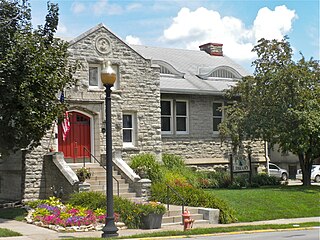 W
WLouisiana Public Library is a historic Carnegie library building located at Louisiana, Pike County, Missouri. It was designed by the architectural firm Mauran, Russell, and Garden and built in 1905. It is a one-story, Late Gothic Revival style rock-faced, cut limestone building on a partially exposed basement. It measures approximately 50 feet by 40 feet and features a front arched doorway with batten doors, eyebrow windows, and stepped parapet. It was constructed with a $10,000 grant from the Carnegie Foundation.
 W
WThe Madison Carnegie Library or Madison Public Library, located at 401 Sixth Avenue, Madison, in the U.S. state of Minnesota is a public library building built in 1905 of brick with limestone trim. Its characteristic features include a columned and pedimented main entrance and a small polygonal dome on its flat roof. The structure was built with an $8,000 grant from Andrew Carnegie. This was one of over 3,000 libraries in 47 states funded by Carnegie. Local residents gave an additional $1,000 in gifts and books at its dedication on January 22, 1906. Gerhard Herriges, a contractor for public buildings in Western Minnesota, built the building for $6,216.85.
 W
WThe Marion Carnegie Public Library is a historic building located in Marion, Iowa, United States. The Marion Federation of Women's Clubs was established in 1901 with the purpose of organizing a public library. Adeliza Daniels was the primary force behind the organization, and she contacted Andrew Carnegie to donate funds for the building. After he agreed to a grant of $11,500, the Cedar Rapids architectural firm of Dieman and Fiske designed the brick Neoclassical building. Cedar Rapids contractor A.H. Conner was responsible for construction. It is a single-story structure built over a raised basement and a proment pedimented main entrance. The new library was dedicated on March 16, 1905, and served the community in that form until 1957. In that year the auditorium in the basement was remodeled into a children's reading room. A three-story addition, which doubled the size of the building, was completed in 1961. The building was individually listed on the National Register of Historic Places in 1994. The Marion Public Library has subsequently moved to a new facility, and the Carnegie building is now part of the First United Methodist Church complex. In 2009 it was included as a contributing property in the Marion Commercial Historic District.
 W
WThe Montrose Library is situated in an A-listed Carnegie funded building in the north Angus coastal town of Montrose. It was first opened in 1905 and in 2018 received a £1 million refurbishment to provide it with "flexible, community focused spaces
 W
WThe Morris Carnegie Library is a former library building in Morris, Minnesota, United States, now occupied by a historical society. It was built in 1905 as one of the 2,500 Carnegie libraries funded by steel magnate Andrew Carnegie. It was listed on the National Register of Historic Places in 1983 for having local significance in the themes of architecture and education. It was nominated for being a longstanding focus of education in Morris, with locally distinctive and well preserved Neoclassical architecture.
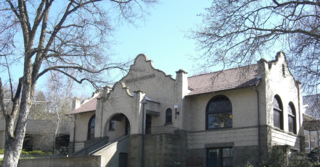 W
WThe Moscow Carnegie Library is a historic building in Moscow, Idaho. It was built as a Carnegie library in 1905, and the front steps were built in the 1930s. It was designed by architect Watson Vernon in the Spanish Colonial Revival style. It has been listed on the National Register of Historic Places since June 18, 1979.
 W
WThe Rensselaer Carnegie Library in Rensselaer, Indiana is a building from 1905. It was listed on the National Register of Historic Places in 1994. The building no longer functions as a library; since 1992 it houses the Prairie Arts Council, a local performing arts organization.
 W
WThe Rice Lake Carnegie Library was a Carnegie library in Rice Lake, Wisconsin. It was built in 1905, replacing a library based in the city's high school, and was one of 63 Carnegie libraries in Wisconsin. The city left the building for a new library in 1978, and the building was demolished on June 26, 1985.
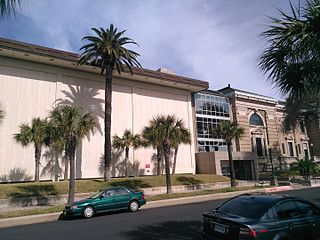 W
WRosenberg Library, a public library located at 2310 Sealy Street in Galveston, Texas, United States, is the oldest continuously operating library in Texas. It serves as headquarters of the Galveston County Library System and its librarian also functions as the Galveston County Librarian.
 W
WThe San Luis Obispo Carnegie Library is a Carnegie library located at 696 Monterey St. in San Luis Obispo, California. The library building was funded by the Carnegie foundation in 1903 and built in 1905; it housed the city's subscription library program, which had operated since 1894. William H. Weeks, who designed 21 Carnegie libraries in California, designed the San Luis Obispo library in the Richardsonian Romanesque style. The library's design includes a tall hipped roof with two gabled wings, decorations including gargoyles in the gable ends, and an entrance portico with multiple round arches. The building is mainly faced in red brick with yellow sandstone trim, but the basement is faced in dark gray granite.
 W
WThe Schomburg Center for Research in Black Culture is a research library of the New York Public Library (NYPL) and an archive repository for information on people of African descent worldwide. Located at 515 Malcolm X Boulevard between West 135th and 136th Streets in the Harlem neighborhood of Manhattan, New York City, it has, almost from its inception, been an integral part of the Harlem community. It is named for Afro-Puerto Rican scholar Arturo Alfonso Schomburg.
 W
WSelly Oak Library is a Carnegie library in Selly Oak, Birmingham, England. It is Grade II listed.
 W
WThe Spokane Public Library is a historic building in Spokane, Washington. It was designed by architects Herman Preusse and Julius Zittel, and built in 1905. Its construction cost $100,000, with $85,000 coming from Andrew Carnegie. It has been listed on the National Register of Historic Places since August 3, 1982.
 W
WThe Sycamore Public Library, in Sycamore, Illinois, was erected in 1905 in the former location of Mansion House, Sycamore's oldest structure. Construction began in May of that year and the library officially opened to the public on Thanksgiving Day, 1905. The library joined the National Register of Historic Places in May 1978 with the rest of the Sycamore Historic District. The library still operates, as of 2019, as the Sycamore library. The library was erected with the help of a $10,000 grant from Andrew Carnegie in 1905.
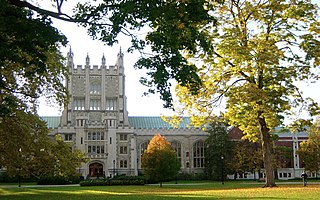 W
WThe Frederick Ferris Thompson Memorial Library is the main library building at Vassar College, in Poughkeepsie, New York.
 W
WThe Tyringham Library is a historic public building at 118 Main Road in Tyringham, Massachusetts. Completed in 1905, it is one of the small town's few buildings exhibiting architectural sophistication, in this case the Arts and Crafts style. The building currently houses both the library and the town post office. It was listed on the National Register of Historic Places in 2018.
 W
WUnion City Public Library is a historic Carnegie library building located at Union City, Randolph County, Indiana. A grant request application was sent to Andrew Carnegie in the Fall of 1903, announcement for the approval of the grant was received in Union City in early December 1903, construction bids were taken in early 1904, ground was broken and foundation construction was started in early June 1904, and the building was completed and the library's collection installed in May, 1905, in time for a public grand opening and celebration held on June 8, 1905. The structure, of which the final design was approved by Carnegie, is a Classical Revival style Indiana limestone building with an upper main floor, and a former basement storage area which has been converted over for a youth services library and programing. Its design features a wooden pediment supported by four Corinthian order limestone columns and a wood balustrade. Its construction was funded by a $10,000 grant from the Carnegie Foundation.
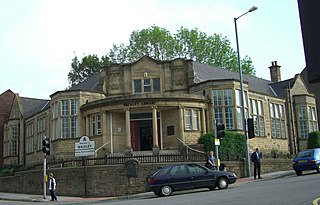 W
WWalkley Library is a public lending library in Walkley, a suburb of the City of Sheffield in England. It stands at the junction of Walkley Road and South Road in one of the busiest parts of the area. It is one of 27 suburban branch libraries within the city. The building is a Carnegie library, the only library in Sheffield to receive Carnegie funding, it is also a Grade II listed building as are the boundary walls and commemorative plaque in front of the library.
 W
WThe Waverly Public Library, located in Waverly, Iowa, is a public library that serves Waverly and the surrounding counties of Bremer and Butler. As of April 2011, the library contains 66,790 volumes, including over 2,000 DVDs and over 1,000 CDs. The library circulates approximately 166,909 items every year.
 W
WThe Woodland Public Library is the oldest, and one of the last functioning Carnegie-funded libraries in California. It is on the National Register of Historic Places and is a contributing property of the Downtown Woodland Historic District.